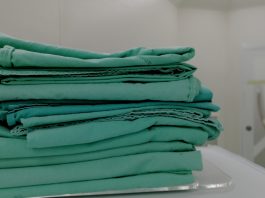A researcher at the University of Borås has developed a purification technique that uses textiles for more efficient wastewater treatment.
Each day, tonnes of toxic waste are produced by households, industries, and agriculture around the world, but in spite of the sheer magnitude of the problem, for decades, authorities have followed traditional biological techniques for wastewater treatment, techniques that in many instances fail to eradicate complex toxins.
Over the years, new purification techniques centred around oxidation have surfaced, but due to their complexity, not even the most advanced have the capability to be put into practise. This is something that Mohammad Neaz Morshed wishes to change through his research.
Morshed’s novel research focuses on how one of the new advanced purification techniques can be made less complex, and the most promising solution includes textiles. More specifically, the solution entails recreating the advanced system for wastewater treatment by applying textiles with specific catalysts on their surface.
The doctoral thesis has been published under the title “Immobilizing catalysts on textiles: case of zerovalent iron and glucose oxidase enzyme”.
Textiles as promising materials
Morshed highlights that there is no easy money to be made in this area, so for people and industries, especially in developing countries, to be encouraged to purify their wastewater before releasing it back to the surface water, a quick, inexpensive and efficient purification process is necessary. According to Morshed’s research findings, textiles are the most promising material for this purpose.
“Textiles are cheap, strong, and flexible and can vary in design so that they fit any purification container. I am convinced that it is an ideal material for this purpose,” he explained.
He then added that textiles, thanks to their many benefits, can be utilised in ways far beyond their initial purpose as clothing, and they are gaining more attention for their potential applications in a range of fields such as medicine and chemistry.
Morshed believes that this is the tip of the iceberg, adding that: “Textiles will soon be able to be used everywhere. Why not also in wastewater treatment?”
Innovation in efficient wastewater treatment
This research is some of the first to offer a textile-based solution for such purification. The key question in the doctoral thesis is whether it is feasible to reconstruct advanced purification systems by employing textiles to immobilise (bind) catalysts. Immobilisation means that the catalysts are attached to a solid support material, in this case textiles. This allows the catalysts to be separated with ease, a process which is essential for a catalytic system to function. Immobilised catalysts can be reused and generally have better stability than those that are not immobilised, but until now, the process is extensive as it necessitated a complex sequence of events and rare support materials.
Various experimental techniques have been utilised to adjust the surface of the textiles and therefore retain the function of the catalysts after they have been immobilised to the textiles. Based on these laboratory experiments, Morshed has demonstrated the feasibility of using textiles to bind catalysts and recreate advanced purification systems.
Resolving global issu es
The outcomes of the research have underlined several possibilities for how catalysts can be immobilised to textiles without having to compromise on their function.
“The research is now at a basic level, but I have managed to establish that textiles have the potential to be used for purification – thus and change the rules of the game,” said Morshed.
Further review is required before the concept can be taken from the laboratory environment to industry. However, Morshed asserted that as the issues surrounding wastewater are global, the conclusive findings will benefit the whole world. He highlighted that the concept will have many exciting applications beyond wastewater treatment; it is just a matter of choosing the right catalysts for each application.
“I feel proud to be able to contribute to solving a global problem and creating a better environment for future generations,” he concluded.









